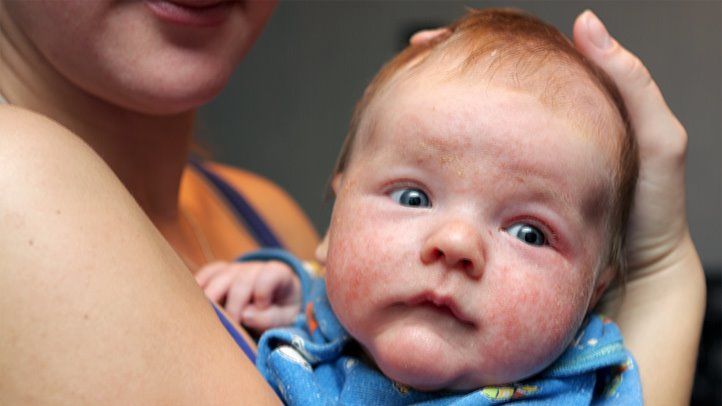Eczema is a common skin condition affecting millions of infants worldwide. Characterized by red, inflamed, and itchy patches of skin, it can cause significant discomfort and concern for both the baby and their parents. This guide aims to provide an exhaustive overview of baby eczema, from recognizing the symptoms to exploring various treatment options. With a focus on practical advice and up-to-date information, parents can feel more confident in managing this condition.
What is Baby Eczema?
Baby eczema, also known as atopic dermatitis, is a chronic skin disorder that primarily affects infants and young children. It is part of the “atopic triad,” which also includes asthma and hay fever, indicating a genetic predisposition to allergic conditions. Eczema often appears in the first six months of life and may persist into adulthood, although some children outgrow it.
Types of Baby Eczema
There are several types of eczema that can affect babies:
- Atopic Dermatitis: The most common form, characterized by dry, itchy, and inflamed skin.
- Contact Dermatitis: Occurs when the skin reacts to direct contact with an irritant or allergen.
- Seborrheic Dermatitis: Often seen on the scalp as cradle cap, it can also affect other oily areas of the body.
- Dyshidrotic Eczema: Involves small blisters on the hands and feet, more common in older children and adults but can occasionally affect infants.
Common Symptoms of Baby Eczema
Recognizing the symptoms of baby eczema early can lead to more effective management and relief. The hallmark of eczema is itchy, red, and inflamed skin, but symptoms can vary depending on the severity and type of eczema.
Red, Inflamed Skin
Eczema often presents as patches of red, inflamed skin. These areas can become swollen and may feel warm to the touch. The redness is due to inflammation, which is the body’s response to perceived threats like allergens or irritants.
Intense Itching
Itching is one of the most distressing symptoms of eczema for both babies and parents. It can lead to constant scratching, which may cause further skin damage and increase the risk of infection.
Dry, Scaly Patches
Dryness is a common feature of eczema-affected skin. The skin may appear rough and scaly, and it may crack, which can be painful and make the baby more susceptible to infections.
Small Raised Bumps
In some cases, eczema can cause small, raised bumps that may ooze or crust over when scratched. These bumps are often filled with fluid and can become infected if not properly cared for.
Crusty Sores
If eczema is left untreated or becomes infected, it can lead to the formation of crusty sores. These sores are a sign of bacterial infection and require medical attention to prevent complications.
Causes and Risk Factors
Eczema results from a complex interplay of genetic, environmental, and immunological factors. Understanding these can help in managing and preventing the condition.
Genetic Predisposition
Eczema is strongly linked to family history. If one or both parents have eczema, asthma, or hay fever, the likelihood of the baby developing eczema increases. Specific genetic mutations affecting the skin barrier function, such as filaggrin mutations, have been identified as contributing factors.
Environmental Triggers
Various environmental factors can trigger or exacerbate eczema symptoms. Common triggers include:
- Allergens: Such as dust mites, pet dander, and pollen.
- Irritants: Including certain soaps, detergents, and fragrances.
- Climate: Extreme temperatures and humidity levels can also impact eczema severity.
- Food Allergies: Some babies with eczema may have sensitivities to certain foods, like dairy, eggs, or nuts.
Immune System Dysfunction
In babies with eczema, the immune system tends to overreact to minor irritants or allergens, causing inflammation and skin symptoms. This overreaction is part of the body’s attempt to protect itself but leads to chronic inflammation and skin barrier disruption.
Diagnosing Baby Eczema
Accurate diagnosis is crucial for effective treatment. A healthcare professional can diagnose eczema based on the baby’s medical history, physical examination, and sometimes additional tests.
Medical History
A comprehensive medical history includes questions about the baby’s symptoms, their onset, duration, and any patterns observed. Family history of atopic conditions is also considered, as it provides clues about genetic predisposition.
Physical Examination
During the physical examination, the doctor will inspect the baby’s skin for signs of eczema, noting the distribution, appearance, and severity of the lesions. The characteristic features of eczema, such as dry, red patches and thickened skin, are usually sufficient for diagnosis.
Skin Tests
In some cases, skin tests may be conducted to identify specific allergens triggering the eczema. Patch testing or allergy testing can help pinpoint environmental or food allergens contributing to the condition. These tests guide targeted avoidance strategies and treatment plans.

Treatment Options for Baby Eczema
Effective management of baby eczema involves a combination of skincare routines, medications, and lifestyle changes. This section covers various treatment modalities and their appropriate use.
Skincare Routine
A gentle and consistent skincare routine is the cornerstone of eczema management. Key elements include:
- Regular Moisturizing: Keeping the skin hydrated helps restore the skin barrier and reduces dryness and itching. Thick, fragrance-free moisturizers are recommended, and should be applied several times a day, especially after bathing.
- Gentle Cleansing: Use mild, fragrance-free cleansers that do not strip the skin of its natural oils. Baths should be lukewarm and limited to 10-15 minutes to prevent excessive drying of the skin.
- Avoiding Harsh Soaps and Detergents: Choose products that are hypoallergenic and free from fragrances and dyes to minimize irritation.
Topical Medications
Topical medications are often prescribed to manage inflammation and itching. These include:
- Corticosteroids: Topical steroids are effective in reducing inflammation and itching. They come in various strengths and should be used as directed by a healthcare provider to avoid potential side effects like skin thinning.
- Calcineurin Inhibitors: These non-steroidal medications (e.g., tacrolimus, pimecrolimus) help reduce inflammation and are suitable for sensitive areas like the face and eyelids. They are often used for long-term management once the eczema is under control.
Systemic Medications
In severe cases, systemic medications may be necessary:
- Oral Corticosteroids: These are prescribed for short-term use in severe flare-ups to quickly reduce inflammation. Long-term use is avoided due to potential side effects.
- Immunosuppressants: Medications like cyclosporine or methotrexate may be used in refractory cases to modulate the immune response. These require careful monitoring due to potential side effects.
Natural and Home Remedies
Many parents explore natural and home remedies to manage their baby’s eczema. While these can provide relief, it’s important to use them safely:
- Coconut Oil: Known for its moisturizing properties, coconut oil can help soothe dry, itchy skin.
- Oatmeal Baths: Colloidal oatmeal baths can reduce itching and inflammation. Adding finely ground oatmeal to bathwater creates a soothing treatment for irritated skin.
- Aloe Vera: Aloe vera gel has anti-inflammatory and moisturizing properties, making it a good option for soothing eczema-affected skin.
Preventing Baby Eczema Flare-Ups
Preventing flare-ups involves avoiding known triggers and maintaining good skincare practices.
Identifying and Avoiding Triggers
To prevent eczema flare-ups, it’s crucial to identify and avoid triggers. Keeping a diary of the baby’s symptoms and potential exposures can help pinpoint specific triggers. Common strategies include:
- Reducing Allergen Exposure: Use dust-mite-proof bedding, maintain a clean home, and avoid pet dander.
- Avoiding Irritants: Choose hypoallergenic and fragrance-free products, and dress the baby in soft, breathable fabrics like cotton.
- Managing Food Allergies: If food allergies are suspected, working with a healthcare provider to identify and eliminate these foods can help reduce flare-ups.
Hypoallergenic Products
Using hypoallergenic products minimizes the risk of skin irritation. Recommendations include:
- Hypoallergenic Moisturizers: Look for products labeled for sensitive skin, free from fragrances and dyes.
- Laundry Detergents: Choose detergents formulated for sensitive skin and ensure thorough rinsing to remove any residue.
Environmental Control
Creating an eczema-friendly environment can help manage symptoms:
- Maintain Optimal Humidity: Use a humidifier during dry seasons to keep indoor air moist.
- Temperature Control: Avoid exposing the baby to extreme temperatures and dress them in layers to regulate body temperature.
Coping with Baby Eczema
Managing baby eczema can be challenging for parents, both emotionally and practically. This section provides strategies for coping and seeking support.
Parental Support and Resources
Connecting with other parents and professionals can provide valuable insights and emotional support:
- Support Groups: Online and local support groups offer a platform to share experiences and advice.
- Professional Counseling: Seeking professional help can assist in managing the stress and anxiety associated with caring for a baby with eczema.
Emotional and Psychological Impact
Eczema can affect a baby’s emotional well-being and development. It’s important to address these aspects by:
- Providing Comfort: Ensuring the baby is comfortable and minimizing scratching can help reduce distress.
- Engaging in Soothing Activities: Gentle massages, singing, and rocking can provide comfort and distraction from itching.

Future Directions in Eczema Research
Research into eczema is ongoing, with new treatments and insights emerging. This section highlights recent advancements and promising future directions.
Recent Advancements
Recent research has led to the development of new medications and treatments, including:
- Biologics: These targeted therapies modulate specific pathways in the immune system, offering a more precise approach to treatment.
- Improved Diagnostic Methods: Advances in diagnostic techniques are helping to better identify and understand eczema triggers and subtypes.
Promising Treatments on the Horizon
Future treatments may offer more effective and lasting relief for eczema sufferers:
- Gene Therapy: Research into gene therapy holds promise for correcting underlying genetic defects associated with eczema.
- New Topical and Systemic Medications: Continued development of safer and more effective medications aims to improve the quality of life for those with eczema.









